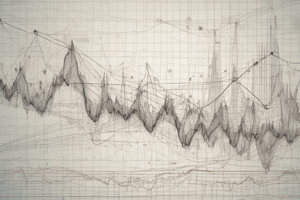Podcast
Questions and Answers
What is the mean of the data set?
What is the mean of the data set?
- 48
- 50 (correct)
- 54
- 52
What is the deviation from the mean for the score 69?
What is the deviation from the mean for the score 69?
- 16
- 19 (correct)
- 21
- 14
What is the sum of the squared deviations from the mean?
What is the sum of the squared deviations from the mean?
- 886 (correct)
- 850
- 900
- 1000
How is the variance calculated for a sample?
How is the variance calculated for a sample?
What is the calculated standard deviation of the data set?
What is the calculated standard deviation of the data set?
Which measure uses all the central points to find deviation?
Which measure uses all the central points to find deviation?
Which of the following is NOT a step in finding the standard deviation?
Which of the following is NOT a step in finding the standard deviation?
What happens to the squared deviation of a score when it is computed?
What happens to the squared deviation of a score when it is computed?
What is the purpose of calculating the standard deviation?
What is the purpose of calculating the standard deviation?
In the given steps, which score has the highest deviation from the mean?
In the given steps, which score has the highest deviation from the mean?
Flashcards are hidden until you start studying
Study Notes
Variance
- Variance is a statistical measurement indicating the spread of numbers in a data set relative to the mean, represented by the symbol σ².
- Variance calculates how far each number deviates from the mean by taking the difference, squaring it, and averaging these squared deviations.
- A high variance indicates greater dispersion from the mean, while a variance of zero means all values are identical.
- Variance values are always non-negative; negative quantities are not possible in this context.
- Squaring deviations treats all differences the same regardless of direction, avoiding the potential for a sum of zero, which indicates variability.
- Extreme values can disproportionately influence variance since squaring amplifies differences from the mean.
- Calculation of variance can be complex and cumbersome, particularly with larger data sets.
- Example: For the numbers 3, 8, 6, 10, 12, 9, 11, 10, 12, 7, the variance is found to be 7.36 after computing deviations and their squares.
Standard Deviation
- Standard deviation measures the degree of dispersion of data points around the mean, revealing the average distance of data points from the mean.
- Different formulas are used for standard deviation based on whether the data represents a full population or a sample.
- Population standard deviation uses the total number of data points (N) in its calculations, while sample standard deviation uses (n - 1).
- Steps to calculate standard deviation include:
- Finding the mean of the data set.
- Calculating each score's deviation from the mean.
- Squaring those deviations to ensure they are positive.
- Summing the squared deviations (sum of squares).
- Dividing the sum of squares by the appropriate value (N for population, n - 1 for samples) to find variance.
- Taking the square root of the variance to derive standard deviation.
- Example with data set {46, 69, 32, 60, 52, 41} results in a mean of 50, a variance of 177.2, and a standard deviation of approximately 13.31, indicating that scores typically deviate by that amount from the mean.
Comparison of Mean Deviation and Standard Deviation
- Mean deviation incorporates all central tendencies (mean, median, mode) while standard deviation relies solely on the mean to determine variability.
- Both mean deviation and standard deviation serve as important measures for analyzing data set distributions.
Studying That Suits You
Use AI to generate personalized quizzes and flashcards to suit your learning preferences.




